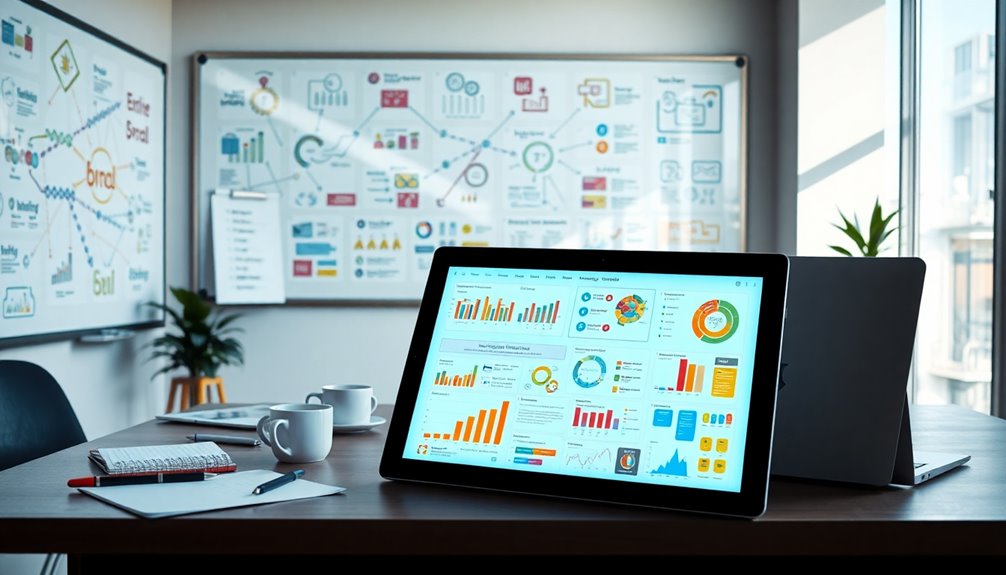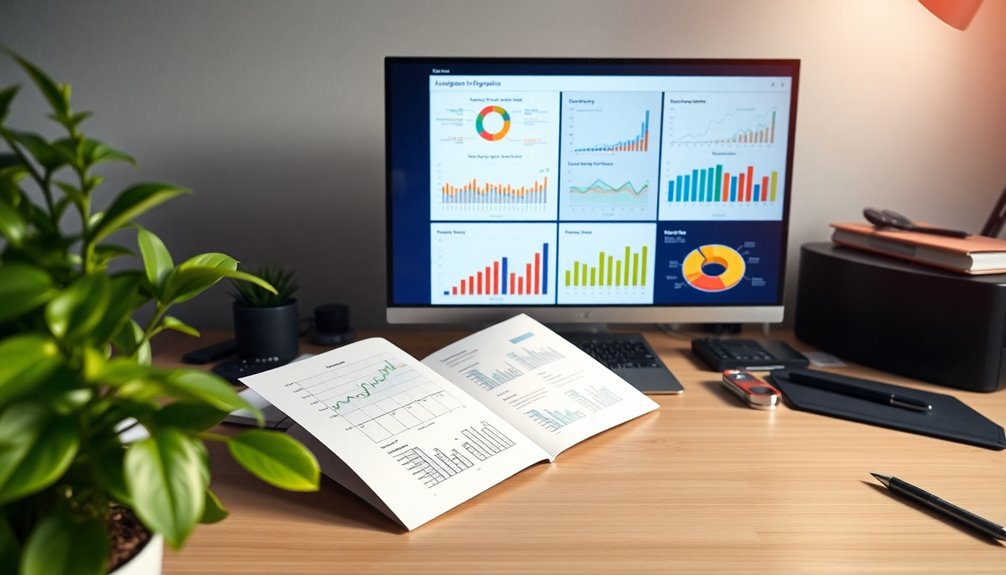To convert complex data into clean, simple infographics, focus on clarity and audience engagement. Start by defining your purpose and knowing your audience. Use reputable data sources and plan a logical structure for your content. When designing, keep it visually appealing with a consistent color palette and clear typography. Finally, promote your infographic across various platforms to reach your audience effectively. There are more strategies to enhance your infographic creation process.
Key Takeaways
- Define the infographic's purpose and audience to guide content and design choices effectively.
- Conduct thorough research and organize data to eliminate inconsistencies, ensuring accuracy and clarity.
- Use visual storytelling techniques, including icons and charts, to simplify complex data into relatable formats.
- Establish a clear hierarchy with typography and color palettes to enhance readability and visual appeal.
- Summarize key takeaways at the end to reinforce understanding and retention of the information presented.
Understanding the Importance of Infographics

When you're trying to convey complex data, infographics play an essential role in making that information accessible and engaging. They enhance visual appeal, capturing your audience's attention while simplifying intricate concepts into a digestible, visual format.
You'll find that visual content considerably improves information retention, making it easier for your audience to remember key points. Infographics also bridge the communication gap between technical details and non-technical audiences, ensuring that insights are accessible to all.
Additionally, their shareability on social media platforms boosts your reach and engagement through effective visual storytelling. By presenting critical metrics and trends clearly and concisely, infographics foster a data-driven environment that can lead to better decision-making in your organization. Moreover, high-quality content plays a crucial role in enhancing the effectiveness of infographics by ensuring that the information presented is credible and trustworthy.
Identifying the Purpose and Audience

Before diving into the design of your infographic, it's essential to identify its purpose and audience. Clearly defining the purpose helps guide your design and content, ensuring you effectively communicate your intended message.
Next, pinpoint your target audience by segmenting them based on demographics, interests, and behavior. This lets you tailor content that resonates with their needs.
Identifying your target audience through segmentation allows for tailored content that truly resonates with their needs.
Creating detailed audience personas can reveal specific pain points and knowledge levels, enhancing your communication strategy. Conduct audience research—like surveys or interviews—to gauge their familiarity with the subject matter, which informs how complex your information should be.
Adjusting the visual design and format based on your audience's preferences improves clarity and engagement, making your data more accessible and understandable. Additionally, incorporating elements like music therapy can enhance emotional engagement and comprehension, particularly for audiences with specific needs.
Collecting and Analyzing Data

To create a compelling infographic, you need to collect and analyze data meticulously. Start by conducting thorough research using reputable sources like government agencies and research institutions. This guarantees the accuracy and relevance of the complex data you gather.
Don't forget to utilize primary data collection methods, such as surveys and interviews, to gain firsthand insights that enhance your narrative. Once you have your data, clean and organize it to eliminate inconsistencies and errors.
Use data visualization tools to identify patterns and trends, highlighting key findings that resonate with your audience. Finally, segment the data according to audience needs and preferences, tailoring your presentation to address specific pain points and improve understanding. Additionally, consider incorporating budgeting techniques to effectively communicate financial data and enhance clarity in your infographic.
Planning and Structuring Your Infographic

When planning your infographic, start by defining its purpose clearly; this will guide your content decisions.
Next, organize your information effectively to guarantee a logical flow that keeps your audience engaged.
Finally, remember to summarize key takeaways at the end so your viewers leave with a solid understanding of your message. Additionally, incorporating strong communication skills into your infographic design can enhance clarity and engagement for your audience.
Define Purpose Clearly
A well-defined purpose is the cornerstone of an effective infographic. When you define purpose clearly, it guides your design and content, ensuring you convey your Key Messages effectively.
Here are four key purposes to evaluate:
- Education: Inform your audience about a specific topic.
- Comparison: Highlight differences or similarities between items.
- Process Explanation: Break down complex processes into understandable steps.
- Data Presentation: Showcase data visually to make it digestible.
Additionally, consider how advance directives can serve as a crucial educational tool, helping individuals understand the importance of planning for medical decisions.
Organize Content Effectively
Organizing your content effectively is essential for creating an impactful infographic, as it guarantees your audience can easily follow the information presented.
Start by developing a clear outline that splits your content into main sections based on key findings, ensuring a logical flow. Include a concise title and an introduction that sets the context for your audience.
Divide the content into distinct sections, each spotlighting specific data aspects, while incorporating supporting details like statistics and examples for clarity.
Utilize visual hierarchy to guide viewers' attention, enhancing comprehension. Additionally, incorporating digital creativity can elevate the overall design and engagement of your infographic.
Summarize Key Takeaways
To effectively communicate your infographic's message, summarizing key takeaways is essential, as it reinforces the main points for your audience.
Here's how to do it effectively:
- Create an Outline: Organize your content into main sections based on key findings to enhance clarity.
- Use a Clear Title: Include a title and introductory statement that communicate the infographic's purpose.
- Divide Content: Break down the information into digestible segments, adding design elements like statistics and examples to support your points.
- Summarize at the End: Conclude with a recap of the key takeaways, ensuring a clear call to action if needed. Additionally, consider incorporating visualization techniques to illustrate complex data simply and engagingly.
Designing the Infographic

When you're designing your infographic, focus on visual appeal and clarity to grab your audience's attention.
A consistent color palette and effective typography hierarchy can make your information more digestible and engaging. Incorporating sustainable fashion elements into your design can resonate well with eco-conscious audiences.
Visual Appeal and Clarity
Creating an infographic that captivates your audience relies heavily on visual appeal and clarity. To achieve this, focus on the following key elements:
- Typography: Use easy-to-read fonts that enhance readability and draw attention.
- Icons and Images: Incorporate relevant visuals to make complex information easy to understand and relatable.
- Whitespace: Strategically use whitespace to prevent clutter, allowing viewers to focus on essential information.
- Hierarchy: Establish a clear information hierarchy through size and placement to guide the audience's eye towards key messages.
Additionally, consider integrating educational philosophies to ensure that your infographic aligns with effective learning strategies.
Consistent Color Palette
Visual appeal and clarity are foundational for effective infographics, and a consistent color palette plays a significant role in achieving that. Use a limited color scheme of 3 to 5 colors to keep your infographic easy to read and visually coherent. Employ contrasting colors to differentiate sections and enhance accessibility. Here's a quick reference table for choosing your colors:
| Color | Psychological Impact |
|---|---|
| Blue | Conveys trust |
| Red | Evokes urgency |
| Green | Represents growth |
Always consider accessibility, incorporating patterns or textures for viewers with color vision deficiencies. A well-planned color palette not only aids brand recognition but also guarantees your information is clear and engaging. Additionally, using a consistent color palette can enhance cognitive function by making the information more digestible for the viewer.
Effective Typography Hierarchy
Clarity is essential in infographic design, and establishing an effective typography hierarchy greatly enhances that.
By implementing clear typography, you can guide your reader's eye and emphasize key information. Here are four tips to achieve this:
- Vary font sizes: Use larger, bolder headings compared to subheadings and body text.
- Maintain a consistent typographic scale: Keep body text at 12-14 points for superior readability.
- Utilize contrasting colors: Confirm text stands out against the background, making key messages easily distinguishable.
- Limit font families: Stick to two or three fonts to create a cohesive look and avoid clutter.
Incorporate whitespace around text elements to enhance comprehension and focus on your infographic's main points.
Tips for Effective Infographic Design

Effective infographic design hinges on a structured layout that organizes information logically. This clear narrative flow helps you communicate the key data points effectively.
Choose a consistent color palette and typography that enhances readability without overwhelming your audience. Avoid overly complex designs that distract from your message.
Incorporate relevant icons, charts, and images to visually represent key concepts, making complex information accessible and engaging. Utilize whitespace strategically to reduce clutter, allowing essential elements to stand out.
Regularly review and refine your design, seeking feedback to spot areas for improvement and ensuring accuracy.
Distributing and Promoting Your Infographic

Once you've created your infographic, distributing and promoting it effectively is essential for maximizing its impact. Here are some key strategies to weigh:
- Share on Your Website: Embed the infographic on relevant blog posts to attract visitors.
- Utilize Social Media: Post it across platforms like Facebook, Twitter, and Instagram to engage your audience.
- Leverage Content Sharing Sites: Use Pinterest and SlideShare to reach broader audiences.
- Implement SEO Optimization: Incorporate relevant keywords in the title, description, and alt text to enhance discoverability.
Engaging with your audience through likes and shares can amplify your infographic's reach.
Collaborating with influencers can also boost promotion, leveraging their networks for greater exposure.
Measuring and Analyzing Performance

To guarantee your infographics deliver real value, it's crucial to measure and analyze their performance regularly. Start by tracking key performance metrics like views, engagement rates—likes, shares, and comments—and the traffic they drive to your website or blog.
These insights reveal your audience's reach and interaction. Don't forget to monitor conversions, such as form submissions or purchases, to assess your infographic's direct impact on business goals.
Monitoring conversions, like form submissions or purchases, is essential to evaluate your infographic's effectiveness on business objectives.
Conduct monthly performance reviews to identify trends and patterns, ensuring your infographics stay effective and aligned with audience preferences.
Gathering audience feedback is crucial too; it helps you understand their likes and improve future designs. Adjust your strategy based on performance data to keep your content relevant and engaging.
Frequently Asked Questions
How Do You Convert Data Into Infographics?
To convert data into infographics, start by defining your core message.
Gather and clean your data, ensuring it's organized to highlight key insights.
Choose visual formats like bar charts or line graphs that clearly represent your information.
Apply design principles, focusing on hierarchy and contrast, to make the infographic appealing yet informative.
Finally, review your work, seek feedback, and iterate for clarity and accuracy before sharing it with your audience.
How Do You Make a Clean Infographic?
Creating a clean infographic's like crafting a clear path through a dense forest.
You start by defining your narrative, guiding viewers with a logical structure. Stick to a consistent color palette and typography to enhance readability, ensuring the visuals support your message.
Organize your content into sections with distinct headings, and use ample white space to avoid clutter.
Finally, choose high-quality visuals that reinforce your story without adding unnecessary noise.
How to Convert Excel Data to Infographic?
To convert Excel data into an infographic, start by cleaning up your data. Remove any unnecessary columns and rows to keep only what's relevant.
Use Excel's built-in charts to create visual representations, like bar or pie charts.
Next, choose an infographic tool like Canva or Piktochart to integrate your visuals.
Finally, add design elements that match your message and review the infographic for clarity to guarantee it effectively communicates your insights.
How Do You Present Data in an Infographic?
To present data in an infographic, start by defining the purpose and audience.
Organize the data logically, breaking it into key sections with clear headings. Use visual elements like charts and icons to make data points easy to interpret.
Keep your design clean by limiting text and using whitespace effectively.
Finally, review your infographic for accuracy and clarity, and seek feedback to refine it before sharing.
Conclusion
To summarize, transforming complex data into engaging infographics can greatly enhance understanding and retention. Did you know that visuals are processed 60,000 times faster than text? By following the steps outlined, you can create infographics that not only convey your message clearly but also captivate your audience. Remember to keep your design simple, focus on your purpose, and promote your work effectively. With the right approach, your infographics can become powerful tools for communication.









